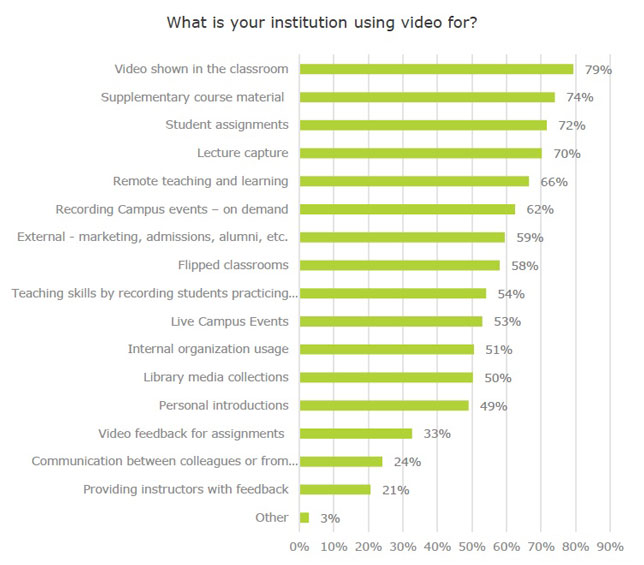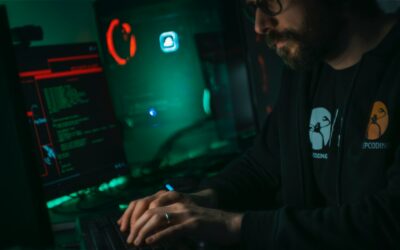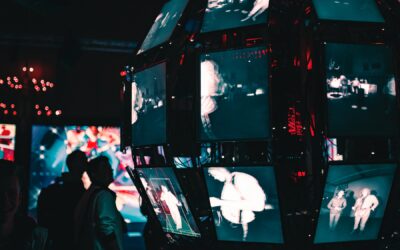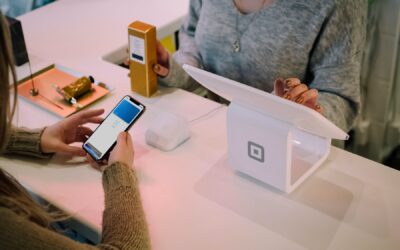Education has always been the prerequisite for a thriving society. The transfer of knowledge and skills to and from people has remained to be a top priority for primitive human tribes, ancient civilizations, and modern society. Successful learning strategies have always revolved around finding ways to make the transfer of knowledge easier, quicker, and of course, more effective.

(Use of video in education. Image: Campustech)
The graph above shows how the relatively established and accessible technology of video is already being used across the teaching space. It has transformed communication between teachers and students and has sped up the learning process in many ways. Virtual reality (VR) provides many additional interactive elements to the traditional use of video.
The evolution of technology and the ongoing strive for better education go hand-in-hand. Historically, most technologies designed to aid education and learning have revolved around enabling access to information, i.e. facts and observations about the world. Before computers and eventually, the internet came along, the most powerful tool that helped us discover and retain factual information was indeed, books.
In today’s era of digitized-everything, it’s difficult to imagine a part of our everyday lives left untouched by technology. This rings true for the way we teach and learn. As technology continues to evolve and become more sophisticated, innovative, and engaging; Virtual Reality (VR) seems to mark the next step in the evolution of education and training.
Improving the quality of education
As we know, education moves closely with technology. Traditional textbooks are being turned into eBooks, online search engines mean learners can find facts and discover new information with just a few clicks, and students are now able to connect with and learn from their teachers remotely – as proven successful during the Covid-pandemic lockdown. There’s no doubt that information, facts, and figures are within far better reach, relative to years ago. However, the current approach to education poses two fundamental problems.
- ‘Fact retention’ is still the main method for measuring the success of learning. Across the education landscape at all levels, teachers are focused on providing the facts. However, it’s been argued that merely having access to and consuming a lot of information isn’t learning. Just as being informed isn’t the same as being educated.
- Difficulties comprehending information isn’t uncommon in education. Especially when too much information is received in a relatively short period of time. It can overwhelm learners and cause them to become bored, disengaged, and unsure about what they’re learning about in the first place.
The power of VR in education
Virtual reality (VR) is an interactive and immersive experience that situates users into a completely new environment. As such, it’s easy to see how VR can be used to enhance student learning and engagement. VR educational content is designed to create a virtual world – real or imagined – for students to delve in, explore, and interact with the world around them.

(Ranking purposes for VR in Europe. Image: Statista)
The basic idea behind VR in education is that by being immersed in the education topic, students are prompted to engage more and therefore fully understand the subject being taught. Since it requires less cognitive load to process the information, students can apply more of their brain functions to actually experiencing history, geography, science, art and everything in between.
Here are just a few of the remarkable ways in which VR in education is so powerful.
Enables a sense of place and presence
Across all disciplines, reading a textbook can only take the student so far. In most cases, when reading about something, or even watching video footage, compels students to want to experience it. VR removes the limitations of word descriptions, book illustrations, and video screen footage. Wherever they are in the world, students can learn about a subject or series of events by immersing themselves into new environments across time and space.
Thanks to the real-feeling of presence VR provides, students can learn by living. Good virtual reality experiences will cause the user to genuinely believe it’s real. This separation from the real and virtual world is blurred and students are as engaged as they would be in a real and exciting setting.
Scalable learning experiences
Science classes and hands-on experiences within the classroom are often limited to available resources and are constricted by safety concerns. Nevertheless, hands-on experiences are still great ways to help students understand how things work based on practical experiences.
VR removes all safety concerns associated with heavy objects, chemical elements, and wildlife, for example. A relatively small AR device can act as an entire science lab or African Safari landscape. VR company Mesmerise, specialises in creating VR training and education content across all settings. Education institutions needn’t worry about the resources allocated to each student – since digital content can effectively be infinite.
Generating an emotional response
Visceral reactions to what we see and experience are fundamental to forming memories. Memories, in turn, play a key role in retaining and retrieving necessary information in the learning process. VR in education is likely to keep students engaged throughout the entire time, making the experiences memorable.
It’s easy to see how a student would be more likely to remember the VR field trip to the Amazon rainforest to learn about endangered species than they would be able to recall the facts, dates and figures from a textbook.
Inspires creativity
Introducing VR into the classroom is a useful way to not only consume digital reality content but to also get involved in the process of creating content. Creativity is the powerhouse behind innovation and big-ideas. Instilling creative concepts into students in the education setting sets them up for success.
Powerful tools like Tilt Brush, which is a room-scale 3D-painting VR app that allows users to virtually create and paint new things in a digital environment; can boost creativity amongst students.

(Forecast size of the AR/VR market globally 2020 and 2025. Image: Statista)
Enhanced visual learning
Data visualization is one of the key attractions of VR for many institutions across sectors. For businesses, it can help decision-making, marketing and complex data management. Within the education sector, the ability to visualize data is key to helping students understand the material.
Many people are indeed visual learners and VR is a helpful tool for this group of learners. Instead of reading about things, or working through spreadsheets to find patterns and answers, VR lets students visualize complex functions or mechanisms to make them easier to comprehend.
The digital generation want to embrace the emerging technology
Most learners of today fall within the generation of those who grew up with fast-paced technology. Unlike students 30 years ago, many learners today probably wouldn’t blink twice about the prospects of learning with VR – in fact, they may well expect it. According to a Greenlight VR survey, the desire to implement VR in education far outweighs the desire for entertainment and gaming content at 63.9% (Fortune).
Since it’s unlikely that technological development will come to a halt, or retract in itself, the learning generation should be exposed to all systems and devices of technology to keep them in line with what’s to come. There’s arguably, no better setting to prepare people for the future of technology, than in the education setting.
How VR can be applied to how we learn and teach
The answer to where we can apply VR in education is almost everywhere. In fact, the only limitations to VR in education are the ones in your imagination. VR opens the virtual door to an infinite set of possibilities that students can experience, engage with and learn from and within. Educational institutions around the world, from primary education to secondary and further education are thinking about ways to incorporate virtual reality into their teaching methods.
Complex training
Highly technical fields across education, from medicine to engineering can provide an enhanced learning experience with VR. For instance, the most significant challenge for medical students learning anatomy is understanding the body in three dimensions and how different health implications react to different treatments. Perhaps that’s why training in this field can be as extensive as up to 10 years in medical school. VR can address this problem, reduce the time required for learning, and produce highly skilled medical practitioners quicker than traditional teaching methods.
For instance, inserting and monitoring intravenous (IV) is an essential part of nursing, since up to 70% of patients having some form of IV device inserted as part of their treatment. When done incorrectly, complications can be as severe as blood infections and mortality. VR app, EON-XR allows for a hands-on immersive experience that allows students to locate the veins and perform the procedure in a safe, risk-free environment. Alongside the procedural instructions, students are presented with additional information such as key terms. This tool is portable and can be integrated into online learning as well as classroom practicals.
Another use of VR in a similar setting is used by Mendel Grammar School in the Czech Republic, which helps students in biology classes learn the anatomy of the eye – a notoriously challenging part of the body to explore in real life. The technology is delivered through a Leap Motion controller and a specially adapted Oculus Rift headset.
Virtual field trips
The capability of VR to offer a deeply immersive sense of place and time makes for an exciting learning experience in history, geography, literature, art, and so much more. Field trips are used in schools and educational institutions as a way to engage students. They’re constricted by commuting and cost, which takes away from the learning experience.
Virtual reality can transport students across the globe in seconds. Within this experience, they can be encouraged to interact with different objects, people, buildings, and machinery. This type of experience is far more enriching than simply reading about it.
One of the most popular VR tools in this space is Google Expeditions. The app is designed to provide a library of field trips available to use via a smartphone. Each experience consists of VR panoramas of different landscapes – from Mars to the Great Wall of China. This app has already proved successful; in education since Google Expeditions has taken over 1 million students in 11 countries on expeditions (The Journal).
Whilst VR field trips shouldn’t necessarily ever replace the real experiences of travel; they can certainly fill in the gaps in the year. For instance, following an in-real-life field trip to Rome, students can save time and costs by experiencing VR field trips to neighboring Italian cities. VR also enables experiences to happen that would otherwise be impossible. Students of science can be transported to outer space or to the interior of a digital space-rocket.
Career expeditions
A critical part of the learning process, at any level of education, is getting exposure to different careers. In the absence of learning about indifferent careers, it can be difficult for students to channel their efforts into a specific end-career goal. Traditionally, students are provided with information on different careers through textbooks and specialist ‘career advisers’. However, the most important part of the career decision-making process is found through experiences and internships.
Virtual reality has the capacity to expose students to real-life settings of different careers. There are no limits to the experiences VR can provide in this space. This can improve students’ abilities to imaging themselves in other professional shoes.
Career expeditions can show students what it’s like to work in any given field. They can access the workspace, the equipment they’d be expected to use, the daily tasks associated with the job, and gain a better understanding of the positives and negatives that come with any career.
Remote learning
More than ever, the need to be able to learn anything from anywhere is imperative. The pandemic and resultant lockdown taught us that anything can disrupt the learning process. With VR on hand, distance learning becomes fun, engaging, and interactive. The best part is that in many cases, the VR experience can be accessed through a smartphone.

(Number of schools turning to remote learning 2020. Image: World Economic Forum)
Ultimately, VR bridges the gap between the learner and the educator. With VR, distance learning content can place teachers and students in the same virtual meeting space with digital representations of themselves. Everyone can be present and everyone can partake in discussions and activities. Much like the physical classroom, teachers can simply teleport into the virtual space and guide students through the learning materials.
Group learning
Collegiality and debate can more often than not, provide students with rich and useful information and guide them to further learning. The importance of group learning, communication, and collaboration cannot be understated and certainly cannot be replaced by lecturers and teachers. The additional content that students happen across during their time communicating and working together can be boosted with VR.
VR presents the opportunity for students to make learning social by creating virtual spaces where students can meet up, communicate and collaborate on projects. The use of avatars and mapped facial expressions means that students can synthesize and learn from one another, outside of the classroom. This is particularly useful in cases where students are unable to meet in real life. This could be down to other commitments, the distance between them, and even time zones. VR combats all these challenges.
Creating VR content for education
There’s a very clear and exciting case for VR in education that is full of potential – much of which is already being implemented. The best news is that we are only in the dawn of this powerful technology and we are braced to overcome the challenges that come with designing VR content for education.
As software developers and hardware engineers also evolve in their own skills, costs come down and VR becomes ever more sophisticated, it’s safe to say that VR in the education space may well become a necessary part of the curriculum. Educators should be mindful of what they should seek to include in their VR learning materials. Effective virtual reality experiences should have the following features to be truly successful.
Features of effective VR learning experiences
- Ease of use – no special skills should be necessary to effectively use the VR app. Students of all ages should be able to navigate and immerse themselves in the VR experience. For remote learning, the only tool students should be expected to use is a smartphone to access VR through a standalone device like Google Cardboard.
- Immersive – Software developers and content designers should aim to create a sense of place to provide students with an immersive experience. There should be interactive features and effective graphics to make the digital world seem real, and disconnect students from their real, physical world.
- Meaningful – The most important feature of any learning material is for it to have meaning. A good VR experience in education can only be backed up by a good story behind it. Advancing in the art of storytelling can be a great way to deliver key insight and meaning that students understand. The best meaningful stories are heard, seen, understood, and inspiring.
- Measurable – Each feature of VR education content should provide a measurable impact. This should enable teachers to track the metrics of education so they can assess each student’s ability and knowledge of a subject. This can be in terms of ease of use, virtual challenges or short quizzes within the VR environment. When designing VR for education, the criterium that will be used to measure success or failure should be made clear.
- Adaptable – VR education experiences should first and foremost allow students at different levels to explore the environment at their own pace. There cannot be one size fits all. Rather, the user should be able to control the level of difficulty. This traditional method of ‘grades’, ‘levels’ and ‘sets’, in the classroom should be extended to the virtual reality experience.
A new role for teachers: What to expect
There will be sure to be a transition from analog teaching methods to digital ones, which will to some degree encompass virtual reality. The shift will ultimately change what teaching looks like, and the role of the teacher will look less like what it does today. The implications of this are twofold. First, trainee teachers will have to learn new digital teaching methods – from the use of VR to teaching remotely. Second, the main role of a teacher will change from content delivery to content facilitation.
By way of explanation, teachers will be expected to focus on creating the conditions for exploration, as opposed to providing ready-made knowledge. This will take the form of arranging classroom spaces for the physical use of VR devices, as well as thinking outside of the box when it comes to supplementary materials.
Traditionally, field trips and extracurricular activities supplemented the curriculum. With limits on finance available, as well as time and practicalities; arranging these activities was somewhat easy to do. Since there are no limits on the application of VR in education, educators will have to get creative and think outside the box when it comes to arranging VR field trips, virtual hangout activities, and the like.
Accessing VR for education experiences
The most significant barrier to using VR in most use-cases is the cost of VR. That’s not to say, however, that the widespread application of VR across the education sector isn’t possible today. Take Google’s Expeditions, for example, as they were able to reach millions of students simply because the hardware they depend on was readily accessible.
In order to make VR education accessible across all settings, the key is to focus on creating VR content that can be supported and delivered through devices that students already have – or can access easily; and then repurpose them into powerful educational tools. Since most students will already own, or have access to a smartphone, the only thing they will need is a headset device costing between £30-£100, such as Google Cardboard or Samsung Gear VR. Giving students good VR experiences should be a priority investment for educators.








